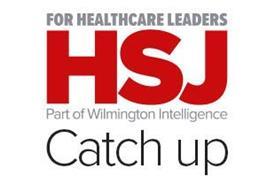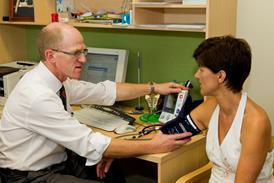Including postoperative haemorrhage, physiologic and metabolic derangement, respiratory failure, and pulmonary embolism
PSI 9: Postoperative Haemorrhage or Haematoma
Metric
Cases of haematoma or haemorrhage requiring a procedure per 1,000 surgical discharges with an operating room procedure.
Numerator
Discharges meeting the inclusion and exclusion rules for the denominator with a secondary diagnosis code of:
T810 - Haemorrhage and haematoma complicating a procedure NEC
T811 - Shock during or resulting from a procedure NEC
Any of the following OPCS codes are required to accompany the above diagnosis codes:
Control of Postoperative Haemorrhage:
F365 + E203 - Arrest of postop bleeding from tonsillar bed + adenoid
H568 + Y443 - Open operations on anus + temporary occlusion of organ NOC
L588 + Y443 - Operations on iliac artery + temporary occlusion of organ NOC
L798 + Y443 - Operations on vena cava + temporary occlusion of organ NOC
M418 + Y443 - Open operations on bladder + temporary occlusion of organ NOC
M708 + Y443 - Operations on outlet of male bladder + temporary occlusion of organ NOC
L126 - Pulmonary artery ligation
L255 - Operations on aortic body + occlusion vessel temporary
L302 - Ligation of carotid artery & Ligation of vein NEC + Jugular body
L333 - Ligation of aneurysm of cerebral artery NEC
L382 - Ligation of subclavian artery
L423 - Ligation Artery Renal
L463 - Ligation of visceral branch of abdominal aorta NEC
L623 - Ligation of aneurysm of popliteal artery
L628 - Other specified other open operations on femoral artery
L663 - Occlusion artery transluminal percutaneous
L691 - Major systemic to pulmonary collateral artery occlusion
L703 - Ligation of artery NEC
L933 - Ligation of vein NEC
L995 - Occlusion vein transluminal percutaneous
Drainage of Haematoma:
D041 - Drainage of haematoma of external ear
T309 - Unspecified opening of abdomen
T301 - Reopening of abdomen, re-exploration of op site, arrest of postop bleeding
N032 - Drainage of scrotum
N131 - Drainage of testis
P292 - Colpotomy NEC
P149 - Unspecified incision of introitus of vagina
P131 + Y221 - Drainage of female perineum + aspiration of haematoma of organ NOC
P093 - Evacuation of haematoma from vulva
P271 - Evacuation of haematoma from vagina
S471 - Drainage of lesion of skin of head or neck
S472 - Drainage of lesion of skin NEC
Denominator
All surgical discharges age 18 and older defined by specific HRGs (Appendix A) and an OPCS code for an operating room procedure.
See Appendix B: Non-Operating Room Procedures
Exclusions
- Primary diagnosis of:
T810 - Haemorrhage and haematoma complicating a procedure NEC
T811 - Shock during or resulting from a procedure NEC
- Control of Postoperative Haemorrhage* (see numerator)
- Drainage of Haematoma* (see numerator)
*If this is the only operating room procedure or if these codes occur before the first operating room procedure
- Pregnancy, childbirth, and puerperium: defined by the following HRG codes:
N06 - Normal Delivery w cc
N07 - Normal Delivery w/o cc
N08 - Assisted Delivery w cc
N09 - Assisted Delivery w/o cc
N10 - Caesarean Section w cc
N11 - Caesarean Section w/o cc
N12 - Antenatal Admissions not Related to Delivery Event
M09 - Threatened or Spontaneous Abortion
M10 - Surgical Termination of Pregnancy
M11 - Medical Termination of Pregnancy
Data Source
SUS - CDS
Time frame
April 2009 - March 2010
Basis
Acute Trust
Statistical methods used
Case-mix adjusted using a logistic regression model.
Logistic regression
The ratio is calculated by dividing the actual number of events by the expected number and multiplying the figure by 100. It is expressed as a relative risk, where a risk rating of 100 represents the national average. If the trust has an RR of 100, that means that the number of events is exactly as it would be expected taking into account the standardisation factors. An RR above 100 means there were more events than would be expected; one below 100 means that fewer than expected events.
Control limits
Control limits tell us the range of values which are consistent with random or chance variation. Data points falling within the control limits are consistent with random or chance variation and are said to display ‘common-cause variation’; for data points falling outside the control limits, chance is an unlikely explanation and hence they are said to display ‘special-cause variation’ - that is, where the trust’s rate diverges significantly from the national rate.
Notes
Based on AHRQ PSI indicators
www.qualityindicators.ahrq.gov/psi_overview.htm
Translated by the Dr Foster Unit at Imperial College
PSI 10: Postoperative Physiologic and Metabolic Derangement
Metric
Cases of specified physiological or metabolic derangement per 1,000 elective surgical discharges with an operating room procedure.
Numerator
Discharges among cases meeting the inclusion and exclusion rules for the denominator with ICD10 codes for physiologic and metabolic derangements in any secondary diagnosis field.
Physiologic And Metabolic Derangements:
a) Ketoacidosis, Hyperosmolarity, or Other Coma:
E100 - Insulin-dependent diabetes mellitus with coma
E101 - Insulin-dependent diabetes mellitus with ketoacidosis
E110 - Non-insulin-dependent diabetes mellitus with coma
E111 - Non-insulin-dependent diabetes mellitus with ketoacidosis
b) Acute Renal Failure*:
N170 - Acute renal failure with tubular necrosis
N171 - Acute renal failure with acute cortical necrosis
N172 - Acute renal failure with medullary necrosis
N178 - Other acute renal failure
N179 - Acute renal failure, unspecified
N19 - Unspecified renal failure
N998 - Other postprocedural disorders of genitourinary system
*Discharges with acute renal failure (subgroup of physiologic and metabolic derangements) must be accompanied by a procedure code for dialysis (X402: Peritoneal dialysis NEC or X403: Haemodialysis NEC).
Denominator
All elective surgical discharges age 18 and over defined by specific HRGs (Appendix A) and an OPCS code for an operating room procedure.
See Appendix B: Non-Operating Room Procedures
Exclusions
- Principal diagnosis of physiologic and metabolic derangements or chronic renal failure
Physiologic And Metabolic Derangements:
E100 - Insulin-dependent diabetes mellitus with coma
E101 - Insulin-dependent diabetes mellitus with ketoacidosis
E110 - Non-insulin-dependent diabetes mellitus with coma
E111 - Non-insulin-dependent diabetes mellitus with ketoacidosis
N170 - Acute renal failure with tubular necrosis
N171 - Acute renal failure with acute cortical necrosis
N172 - Acute renal failure with medullary necrosis
N178 - Other acute renal failure
N179 - Acute renal failure, unspecified
N19 - Unspecified renal failure
N998 - Other postprocedural disorders of genitourinary system
Chronic Renal Failure:
I120 - Hypertensive renal disease with renal failure
I131 - Hypertensive heart and renal disease with renal failure
I132 - Hyper heart and renal dis both (cong) heart and renal fail
N18 - Chronic renal failure
• With acute renal failure where a procedure for dialysis occurs before or on the same day as the first operating room procedure i.e. dialysis procedures X402 or X403 must occur with acute renal failure (N17) in any secondary diagnosis field, if before or on same day as first operating room procedure.
• With both a diagnosis code of ketoacidosis, hyperosmolarity, or other coma (codes as per numerator) and a principal diagnosis of diabetes.
Diabetes:
E10 - Insulin-dependent diabetes mellitus
E11 - Non-insulin-dependent diabetes mellitus
E12 - Malnutrition-related diabetes mellitus
E13 - Other specified diabetes mellitus
E14 - Unspecified diabetes mellitus
• With both a secondary diagnosis code for acute renal failure (N17) and a principal diagnosis of acute myocardial infarction, cardiac arrhythmia, cardiac arrest, shock, haemorrhage, or gastrointestinal haemorrhage.
Acute Myocardial Infarction:
I210 - Acute transmural myocardial infarction of anterior wall
I211 - Acute transmural myocardial infarction of inferior wall
I212 - Acute transmural myocardial infarction of other sites
I213 - Acute transmural myocardial infarction of unspecified site
I214 - Acute subendocardial myocardial infarction
Cardiac Arrhythmia:
I442 - Atrioventricular block, complete
I471 - Supraventricular tachycardia
I472 - Ventricular tachycardia
I479 - Paroxysmal tachycardia, unspecified
I48 - Atrial fibrillation and flutter
I490 - Ventricular fibrillation and flutter
I499 - Cardiac arrhythmia, unspecified
Cardiac Arrest:
I469 - Cardiac arrest, unspecified
Shock:
A419 - Septicaemia, unspecified
O033 - Incomplete spont abort with other and unspec complication
O038 - Complete or unsp spont abort comp with other & unsp comp
O043 - Incomplete med abort with other and unsp complication
O048 - Complete or unspec med abort comp by with other & unsp comp
O053 - Incomplete other abortion with other and unsp complication
O058 - Complete/unsp other abortion comp with other & unsp comp
O063 - Incomplete unspec abortion comp with other and unspec comp
O068 - Unspec abort, complete/unspec with other & unsp compl
O073 - Failed medical abortion with other/unspecified complication
O083 - Shock following abortion and ectopic and molar pregnancy
O150 - Eclampsia in pregnancy
O751 - Shock during or following labour and delivery
O908 - Other complications of the puerperium
R570 - Cardiogenic shock
R578 - Other shock
R579 - Shock, unspecified
T782 - Anaphylactic shock, unspecified
T805 - Anaphylactic shock due to serum
T811 - Shock during or resulting from a procedure NEC
T882 - Shock due to anaesthesia
Haemorrhage:
D62 - Acute posthaemorrhagic anaemia
R58 - Haemorrhage NEC
T792 - Traumatic secondary and recurrent haemorrhage
T810 - Haemorrhage and haematoma complicating a procedure NEC
Gastrointestinal Haemorrhage:
I850 - Oesophageal varices with bleeding
I982 - Oesophageal varices in diseases classified elsewhere
K226 - Gastro-oesophageal laceration-haemorrhage syndrome
K228 - Other specified diseases of oesophagus
K25 - Gastric ulcer
K250 -Gastric ulcer, acute with haemorrhage
K252 - Gastric ulcer, acute with both haemorrhage and perforation
K254 - Gastric ulcer, chronic or unspecified with haemorrhage
K256 - Gastric ulcer, chronic or unspecified with both haemorrhage and perforation
K260 - Duodenal ulcer, acute with haemorrhage
K262 - Duodenal ulcer, acute with both haemorrhage and perforation
K264 - Duodenal ulcer, chronic or unspecified with haemorrhage
K266 - Duodenal ulcer, chronic or unspecified: both haemorrhage & perforation
K270 - Peptic ulcer, acute with haemorrhage
K272 - Peptic ulcer, acute with both haemorrhage and perforation
K274 - Peptic ulcer, chronic or unspecified with haemorrhage
K276 - Peptic ulcer, chronic or unspecified with both haemorrhage and perforation
K280 - Gastrojejunal ulcer, acute with haemorrhage
K282 - Gastrojejunal ulcer, acute with both haemorrhage and perforation
K284 - Gastrojejunal ulcer, chronic or unspecified with haemorrhage
K286 - Gastrojejunal ulcer, chronic or unspecified: both haemorrhage & perforation
K290 - Acute haemorrhagic gastritis
K317 - Polyp of stomach and Duodenum
K318 - Other specified diseases of stomach and duodenum
K552 - Angiodysplasia of colon
K571 - Diverticular dis of small intestine without perf or abscess
K572 - Diverticular dis of large intestine with perf and abscess
K625 - Haemorrhage of anus and rectum
K920 - Haematemesis
K921 - Melaena
K922 - Gastrointestinal haemorrhage, unspecified
• Pregnancy, childbirth, and puerperium. Defined by the following HRG codes:
N06 - Normal Delivery w cc
N07 - Normal Delivery w/o cc
N08 - Assisted Delivery w cc
N09 - Assisted Delivery w/o cc
N10 - Caesarean Section w cc
N11 - Caesarean Section w/o cc
N12 - Antenatal Admissions not Related to Delivery Event
M09 - Threatened or Spontaneous Abortion
M10 - Surgical Termination of Pregnancy
M11 - Medical Termination of Pregnancy
Data Source
SUS - CDS
Time frame
April 2009 - March 2010
Basis
Acute Trust
Statistical methods used
Case-mix adjusted using a logistic regression model.
Logistic regression
The ratio is calculated by dividing the actual number of events by the expected number and multiplying the figure by 100. It is expressed as a relative risk, where a risk rating of 100 represents the national average. If the trust has an RR of 100, that means that the number of events is exactly as it would be expected taking into account the standardisation factors. An RR above 100 means there were more events than would be expected; one below 100 means that fewer than expected events.
Control limits
Control limits tell us the range of values which are consistent with random or chance variation. Data points falling within the control limits are consistent with random or chance variation and are said to display ‘common-cause variation’; for data points falling outside the control limits, chance is an unlikely explanation and hence they are said to display ‘special-cause variation’ - that is, where the trust’s rate diverges significantly from the national rate.
Notes
Based on AHRQ PSI indicators
www.qualityindicators.ahrq.gov/psi_overview.htm
Translated by the Dr Foster Unit at Imperial College
PSI 11: Postoperative Respiratory Failure
Metric
Cases of acute respiratory failure per 1,000 elective surgical discharges with an operating room procedure.
Numerator
Discharges among cases meeting the inclusion and exclusion rules for the denominator with ICD10 codes for ‘Respiratory failure, unspecified’ (J969) in any secondary diagnosis.
OR
Discharges among cases meeting the inclusion and exclusion rules for the denominator with OPCS codes as follows:
- E411: Open insertion of tubal prosthesis in trachea one or more days after the major operating room procedure code
- E851: Invasive ventilation two or more days after the major operating room procedure
Denominator
All elective surgical discharges age 18 and over defined by specific HRGs (Appendix A) and an OPCS code for an operating room procedure.
See Appendix B: Non-Operating Room Procedures
Exclusions
- Primary diagnosis of ‘Respiratory failure, unspecified’ (J969)
- where a procedure for tracheostomy (E42.2, E42.3, E42.5) is the only operating room procedure or tracheostomy occurs before the first operating room procedure
- Pregnancy, childbirth, and puerperium: defined by the following HRG codes:
N06 - Normal Delivery w cc
N07 - Normal Delivery w/o cc
N08 - Assisted Delivery w cc
N09 - Assisted Delivery w/o cc
N10 - Caesarean Section w cc
N11 - Caesarean Section w/o cc
N12 - Antenatal Admissions not Related to Delivery Event
M09 - Threatened or Spontaneous Abortion
M10 - Surgical Termination of Pregnancy
M11 - Medical Termination of Pregnancy
Data Source
SUS - CDS
Time frame
April 2009 - March 2010
Basis
Acute Trust
Statistical methods used
Case-mix adjusted using a logistic regression model.
Logistic regression
The ratio is calculated by dividing the actual number of events by the expected number and multiplying the figure by 100. It is expressed as a relative risk, where a risk rating of 100 represents the national average. If the trust has an RR of 100, that means that the number of events is exactly as it would be expected taking into account the standardisation factors. An RR above 100 means there were more events than would be expected; one below 100 means that fewer than expected events.
Control limits
Control limits tell us the range of values which are consistent with random or chance variation. Data points falling within the control limits are consistent with random or chance variation and are said to display ‘common-cause variation’; for data points falling outside the control limits, chance is an unlikely explanation and hence they are said to display ‘special-cause variation’ - that is, where the trust’s rate diverges significantly from the national rate.
Notes
Based on AHRQ PSI indicators
www.qualityindicators.ahrq.gov/psi_overview.htm
Translated by the Dr Foster Unit at Imperial College
PSI 12: Postoperative Pulmonary Embolism or Deep Vein Thrombosis
Metric
Number of infections per 1,000 spells
Numerator
Discharges among cases meeting the inclusion and exclusion rules for the denominator with ICD-10 codes for deep vein thrombosis or pulmonary embolism in any secondary diagnosis field
See Appendix A: Pulmonary Embolism/Deep Vein Thrombosis Diagnosis Codes
Denominator
All surgical discharges age 18 and older defined by specific HRGs and excluding all non-operating room procedures (Appendix C).
See Appendix B: Non-operating Room Procedure Codes
Exclude cases
Exclude cases:
- principal diagnosis of deep vein thrombosis or pulmonary embolism
- where a procedure for interruption of vena cava is the only operating room procedure or is the same day or before the first operating room procedure
- pregnancy, childbirth, and puerperium HRGs (M09, M10, M11, N06, N07, N08, N09, N10, N11, N12)
See Appendix A: Pulmonary Embolism/Deep Vein Thrombosis Diagnosis Codes
OPCS-4 Interruption Of Vena Cava procedure codes:
OPCS-4 - Description
L791 - Insertion of filter into vena cava
L792 - L79.2 - plication of vena cava or other specified other operations on vena cava
L798 - Repair of wound of major artery or vein of abdomen (including aorta and vena cava)
Data Source
SUS - CDS
Time frame
April 2009 - March 2010
Basis
Acute Trust
Statistical methods used
Case-mix adjusted using a logistic regression model.
Logistic regression
The ratio is calculated by dividing the actual number of events by the expected number and multiplying the figure by 100. It is expressed as a relative risk, where a risk rating of 100 represents the national average. If the trust has an RR of 100, that means that the number of events is exactly as it would be expected taking into account the standardisation factors. An RR above 100 means there were more events than would be expected; one below 100 means that fewer than expected events.
Control limits
Control limits tell us the range of values which are consistent with random or chance variation. Data points falling within the control limits are consistent with random or chance variation and are said to display ‘common-cause variation’; for data points falling outside the control limits, chance is an unlikely explanation and hence they are said to display ‘special-cause variation’ - that is, where the trust’s rate diverges significantly from the national rate.
Notes
Based on AHRQ PSI indicators
www.qualityindicators.ahrq.gov/psi_overview.htm
Translated by the Dr Foster Unit at Imperial College
PSI 13: Post-operative sepsis
Metric
Cases of sepsis per 1,000 elective surgery patients with an operating room procedure and a length of stay of 4 days or more.
Numerator
- Sepsis codes in any secondary diagnosis field
ICD code - Description
A40 - Streptococcal septicaemia
A41 - Other septicaemia
T826 - Infection and inflammatory reaction due to cardiac valve prosthesis
T827 - Infection and inflammatory reaction due to other cardiac and vascular devices, implants and grafts
T835 - Infection and inflammatory reaction due to prosthetic device, implant and graft in urinary system
T836 - Infection and inflammatory reaction due to prosthetic device, implant and graft in genital tract
T845 - Infection and inflammatory reaction due to internal joint prosthesis
T846 - Infection and inflammatory reaction due to internal fixation device [any site]
T847 - Infection and inflammatory reaction due to other internal orthopaedic prosthetic devices, implants and grafts
T857 - Infection and inflammatory reaction due to other internal prosthetic devices, implants and grafts
T811 - Shock during or resulting from a procedure, not elsewhere classified
Denominator
- All elective (ADMIMETH=11-13)
- Surgical discharges
- Aged 18 and older
- Defined by specific HRGs and an OPCS code for an operating room procedure
See Appendix B. Exclusions for operating theatre procedure codes
Exclude cases
- with sepsis codes in the primary diagnosis field
- with a principal diagnosis of infection, or any code for immunocompromised state, or cancer
- pregnancy, childbirth, and puerperium
- LOS < 4 days
See Appendix C: Codes for immunocompromised states
See Appendix E: Infection codes
Pregnancy, childbirth, and puerperium: defined by primary diagnosis using O chapter
Time frame
April 2009- March 2010
Basis
Acute Trust
Statistical methods used
Case-mix adjusted using a logistic regression model.
Logistic regression
The ratio is calculated by dividing the actual number of events by the expected number and multiplying the figure by 100. It is expressed as a relative risk, where a risk rating of 100 represents the national average. If the trust has an RR of 100, that means that the number of events is exactly as it would be expected taking into account the standardisation factors. An RR above 100 means there were more events than would be expected; one below 100 means that fewer than expected events.
Control limits
Control limits tell us the range of values which are consistent with random or chance variation. Data points falling within the control limits are consistent with random or chance variation and are said to display ‘common-cause variation’; for data points falling outside the control limits, chance is an unlikely explanation and hence they are said to display ‘special-cause variation’ - that is, where the trust’s rate diverges significantly from the national rate.
Notes
Based on AHRQ PSI indicators
www.qualityindicators.ahrq.gov/psi_overview.htm
Translated by the Dr Foster Unit at Imperial College
PSI 14: Postoperative Wound Dehiscence
Metric
Cases of reclosure of postoperative disruption of abdominal wall per 1,000 cases of abdominopelvic surgery.
Numerator
Discharges among cases meeting the inclusion and exclusion rules for the denominator with an OPCS procedure code for reclosure of postoperative disruption of abdominal wall (T283) in any procedure field.
Denominator
All abdominopelvic surgical discharges age 18 and over defined by specific OPCS procedure codes (Appendix A).
See Appendix A: Abdominopelvic Surgical Procedures
Exclusions
- Where a procedure for reclosure of postoperative disruption of abdominal wall (OPCS procedure code: T283) occurs before or on the same day as the first abdominopelvic surgery procedure.
- With immunocompomised state (see Appendix B).
- Where length of stay is less than 2 days (< 2 days).
- Pregnancy, childbirth, and puerperium: defined by the following HRG codes:
N06 - Normal Delivery w cc
N07 - Normal Delivery w/o cc
N08 - Assisted Delivery w cc
N09 - Assisted Delivery w/o cc
N10 - Caesarean Section w cc
N11 - Caesarean Section w/o cc
N12 - Antenatal Admissions not Related to Delivery Event
M09 - Threatened or Spontaneous Abortion
M10 - Surgical Termination of Pregnancy
M11 - Medical Termination of Pregnancy
Data Source
SUS - CDS
Time frame
April 2009 - March 2010
Basis
Acute Trust
Statistical methods used
Case-mix adjusted using a logistic regression model.
Logistic regression
The ratio is calculated by dividing the actual number of events by the expected number and multiplying the figure by 100. It is expressed as a relative risk, where a risk rating of 100 represents the national average. If the trust has an RR of 100, that means that the number of events is exactly as it would be expected taking into account the standardisation factors. An RR above 100 means there were more events than would be expected; one below 100 means that fewer than expected events.
Control limits
Control limits tell us the range of values which are consistent with random or chance variation. Data points falling within the control limits are consistent with random or chance variation and are said to display ‘common-cause variation’; for data points falling outside the control limits, chance is an unlikely explanation and hence they are said to display ‘special-cause variation’ - that is, where the trust’s rate diverges significantly from the national rate.
Notes
Based on AHRQ PSI indicators
www.qualityindicators.ahrq.gov/psi_overview.htm
Translated by the Dr Foster Unit at Imperial College
PSI 15: Accidental Puncture or Laceration
Metric
Cases of accidental cut, puncture, perforation or laceration per 1,000 surgery discharges.
Numerator
Discharges among cases meeting the inclusion and exclusion rules for the denominator with ICD10 code denoting accidental cut, puncture, perforation or laceration during a procedure in any secondary diagnosis field.
ICD10 Unintentional cut, puncture, perforation or haemorrhage during surgical and medical care:
ICD code - Description
Y600 - During surgical operation
Y601 - During infusion or transfusion
Y602 - During kidney dialysis or other perfusion
Y603 - During injection or immunization
Y604 - During endoscopic examination
Y606 - During aspiration, puncture and other catheterization
Y605 - During heart catheterization
Y607 - During administration of enema
Y608 - During other surgical and medical care
Y609 - During unspecified surgical and medical care
T812 - Accidental puncture and laceration during a procedure NEC
Denominator
All surgical and medical discharges age 18 years and older defined by specific HRG codes
See Appendix A: Surgical and medical HRGs
Exclusions
- Primary diagnosis denoting accidental cut, puncture, perforation, or laceration.
- Pregnancy, childbirth, and puerperium: defined by the following HRG codes:
HRG - Description
N06 - Normal Delivery w cc
N07 - Normal Delivery w/o cc
N08 - Assisted Delivery w cc
N09 - Assisted Delivery w/o cc
N10 - Caesarean Section w cc
N11 - Caesarean Section w/o cc
N12 - Antenatal Admissions not Related to Delivery Event
M09 - Threatened or Spontaneous Abortion
M10 - Surgical Termination of Pregnancy
M11 - Medical Termination of Pregnancy
Data Source
SUS - CDS
Time frame
April 2009 - March 2010
Basis
Acute Trust
Statistical methods used
Case-mix adjusted using a logistic regression model.
Logistic regression
The ratio is calculated by dividing the actual number of events by the expected number and multiplying the figure by 100. It is expressed as a relative risk, where a risk rating of 100 represents the national average. If the trust has an RR of 100, that means that the number of events is exactly as it would be expected taking into account the standardisation factors. An RR above 100 means there were more events than would be expected; one below 100 means that fewer than expected events.
Control limits
Control limits tell us the range of values which are consistent with random or chance variation. Data points falling within the control limits are consistent with random or chance variation and are said to display ‘common-cause variation’; for data points falling outside the control limits, chance is an unlikely explanation and hence they are said to display ‘special-cause variation’ - that is, where the trust’s rate diverges significantly from the national rate.
Notes
Based on AHRQ PSI indicators
www.qualityindicators.ahrq.gov/psi_overview.htm
Translated by the Dr Foster Unit at Imperial College
PSI 3: Decubitus Ulcer
Numerator
All spells with ICD10 code for decubitus ulcer in any secondary field
ICD10 code
L89 Decubitus Ulcer
Denominator
All surgical and medical spells in patients aged 18 and over, defined by specific HRG codes
Exclude cases
- With length of stay less than 5 days
- With ICD10 code of decubitus ulcer (see numerator) in the principal diagnosis field
- See Appendix C: Exclusions for operating theatre procedure codes
- Any diagnosis of ICD10 codes for Hemiplegia, paraplegia, quadriplegia, spina bifida or anoxic brain damage.
ICD10 code - Description
- G801 Spastic diplegia
- G802 Infantile hemiplegia
- G808 Other infantile cerebral palsy
- G809 Infantile cerebral palsy, unspecified
- G810 Flaccid hemiplegia
- G811 Spastic hemiplegia
- G819 Hemiplegia, unspecified
- G822 Paraplegia, unspecified
- G825 Tetraplegia, unspecified
- G830 Diplegia of upper limbs
- G831 Monoplegia of lower limb
- G832 Monoplegia of upper limb
- G833 Monoplegia, unspecified
- G834 Cauda equina syndrome
- G838 Other specified paralytic syndromes
- G839 Paralytic syndrome, unspecified
- N319 Neuromuscular dysfunction of bladder, unspecified
With an OPCS procedure code for debridement or pedicle graft op before or on the same day as the major operating room procedure (surgical cases only)
OPCS code - Description
- T778 Other specified excision of muscle
- S571 Debridement of skin NEC (includes excision of devitalised skin)
- S573 Toilet of skin NEC
- S17 + Y703 Distant flap of skin & muscle (first stage of staged operations NOC)
- S18 + Y703 Distant flap of skin & fascia (first stage of staged operations NOC)
- S19 + Y703 Distant pedicle flap of skin (first stage of staged operations NOC)
- S24 + Y703 Local flap of skin & muscle (first stage of staged operations NOC)
- S25 + Y703 Local flap of skin & fascia (first stage of staged operations NOC)
- S26 + Y703 Local pedicle flap of skin (first stage of staged operations NOC)
- S17 + Y713 Distant flap of skin & muscle (Revisional operations NOC)
- S18 + Y713 Distant flap of skin & fascia (Revisional operations NOC)
- S19 + Y713 Distant pedicle flap of skin (Revisional operations NOC)
- S24 + Y713 Local flap of skin & muscle (Revisional operations NOC)
- S25 + Y713 Local flap of skin & fascia (Revisional operations NOC)
- S26 + Y713 Local pedicle flap of skin (Revisional operations NOC)
• Admission source (ADMISORC) indicating long-term care
- 54 NHS run nursing home, residential care home or group home
- 85 Non-NHS (other than Local Authority) run residential care home (from 1996-97)
- 86 Non-NHS (other than Local Authority) run nursing home (from 1996-97)
- 88 non-NHS (other than Local Authority) run hospice
• Transferred from acute care facility
- Transfer (ADMIMETH=81 or ADMISORC=50-54 or DISDEST of pre-transfer spell=50-54) plus previous trust is acute plus at most two days between end of previous spell and current spell
Data Source
SUS - CDS
Time frame
April 2009 - March 2010
Basis
Acute Trust
Statistical methods used
Case-mix adjusted using a logistic regression model.
Logistic regression
The ratio is calculated by dividing the actual number of events by the expected number and multiplying the figure by 100. It is expressed as a relative risk, where a risk rating of 100 represents the national average. If the trust has an RR of 100, that means that the number of events is exactly as it would be expected taking into account the standardisation factors. An RR above 100 means there were more events than would be expected; one below 100 means that fewer than expected events.
Control limits
Control limits tell us the range of values which are consistent with random or chance variation. Data points falling within the control limits are consistent with random or chance variation and are said to display ‘common-cause variation’; for data points falling outside the control limits, chance is an unlikely explanation and hence they are said to display ‘special-cause variation’ - that is, where the trust’s rate diverges significantly from the national rate.
Notes
Based on AHRQ PSI indicators
www.qualityindicators.ahrq.gov/psi_overview.htm
Translated by the Dr Foster Unit at Imperial College
PSI 4: Failure to Rescue
Metric
Number of deaths per 1,000 spells
Numerator
Discharges with a method of discharge of death (DISMETH = 4) among cases meeting the inclusion and exclusion rules for the denominator.
Denominator
All surgical discharges aged 18-90 defined by specific HRGs (Appendix A) with a secondary diagnosis code for potential complications of care (Appendix B).
Inclusions
The admission was either
- elective (admission method equal to 11, 12 or 13) or
- an emergency admission (admission method equal to 21, 22, 23, 24 or 28) where the principal operating room procedure took place in <= 2 days of admission.
Exclusions
- External transfers or unknown transfers (DISDEST = 49-53 but no subsequent spell found) and
- all non-operating room procedures (Appendix C).
Spells which satisfied the following criteria:
- See Appendix A: Surgical HRGs
- See Appendix B: Potential Complications of Care Diagnoses
- See Appendix C: Non-Operating Room Procedures
Data Source
SUS - CDS
Time frame
April 2009 - March 2010
Basis
Acute Trust
Statistical methods used
Case-mix adjusted using a logistic regression model.
Logistic regression
The ratio is calculated by dividing the actual number of events by the expected number and multiplying the figure by 100. It is expressed as a relative risk, where a risk rating of 100 represents the national average. If the trust has an RR of 100, that means that the number of events is exactly as it would be expected taking into account the standardisation factors. An RR above 100 means there were more events than would be expected; one below 100 means that fewer than expected events.
Control limits
Control limits tell us the range of values which are consistent with random or chance variation. Data points falling within the control limits are consistent with random or chance variation and are said to display ‘common-cause variation’; for data points falling outside the control limits, chance is an unlikely explanation and hence they are said to display ‘special-cause variation’ - that is, where the trust’s rate diverges significantly from the national rate.
Notes
For emergency admissions, the principal operating room procedure date was searched for within the first two episodes of the spell, to check that the procedure took place within two days of the admission date and not just the start of the episode.
Based on AHRQ PSI indicators
www.qualityindicators.ahrq.gov/psi_overview.htm
Translated by Peter Griffiths and Simon Jones, Kings College London and Alex Bottle from the Dr Foster Unit at Imperial College
PSI 7: Infections associated with central line (formerly “selected infections due to medical care”)
Numerator
ICD10 code in secondary diagnosis fields:
T802 Infections following infusion transfusion & therap inject
Denominator
All surgical and medical spells in patients aged 18 and over, defined by specific HRG codes, or pregnancy, childbirth, and puerperium
Pregnancy, childbirth, and puerperium: defined by the following HRG codes:
N06 Normal Delivery w cc
N07 Normal Delivery w/o cc
N08 Assisted Delivery w cc
N09 Assisted Delivery w/o cc
N10 Caesarean Section w cc
N11 Caesarean Section w/o cc
N12 Antenatal Admissions not Related to Delivery Event
M09 Threatened or Spontaneous Abortion
M10 Surgical Termination of Pregnancy
M11 Medical Termination of Pregnancy
Exclude cases
- With numerator ICD code in the primary diagnosis field
- Length of stay <2 days
- With any code for immunocompromised state or cancer
See Appendix B: Codes for immunocompromised states
Data Source
SUS - CDS
Time frame
April 2009 - March 2010
Basis
Acute Trust
Statistical methods used
Case-mix adjusted using a logistic regression model.
Logistic regression
The ratio is calculated by dividing the actual number of events by the expected number and multiplying the figure by 100. It is expressed as a relative risk, where a risk rating of 100 represents the national average. If the trust has an RR of 100, that means that the number of events is exactly as it would be expected taking into account the standardisation factors. An RR above 100 means there were more events than would be expected; one below 100 means that fewer than expected events.
Control limits
Control limits tell us the range of values which are consistent with random or chance variation. Data points falling within the control limits are consistent with random or chance variation and are said to display ‘common-cause variation’; for data points falling outside the control limits, chance is an unlikely explanation and hence they are said to display ‘special-cause variation’ - that is, where the trust’s rate diverges significantly from the national rate.
Notes
The code relating to cardiac devices (T827: Infect inflamm reaction due to other cardiac vascular devices, implants and graft) has now been removed as it was considered to be less important and relevant to a different type of patient from those with central lines in place.
Based on AHRQ PSI indicators
www.qualityindicators.ahrq.gov/psi_overview.htm
Translated by the Dr Foster Unit at Imperial College
PSI 8: Post-operative hip fracture
Numerator
Hip fracture codes in any secondary diagnosis field
ICD codes
- S720 Fracture of neck of femur
- S721 Pertrochanteric fracture
- S722 Subtrochanteric fracture
Denominator
- All surgical discharges age 18 and older defined by specific HRGs and an OPCS code for an operating room procedure
- See Appendix A: Surgical HRGs
- See Appendix B. Exclusions for operating theatre procedure codes
Exclude cases
- Hip fracture codes in the primary diagnosis field
- where the only operating room procedure is hip fracture repair (see Appendix A)
- where a procedure for hip fracture repair occurs before or on the same day as the first operating room procedure
- spells with diseases and disorders of the musculoskeletal system and connective tissue in the primary diagnosis field (ICD M and O chapters)
- with primary diagnosis codes for seizure, syncope, stroke, coma, cardiac arrest, poisoning, trauma, delirium and other psychoses, or anoxic brain injury (see Appendix B for codes)
- with any diagnosis of metastatic cancer, lymphoid malignancy or bone malignancy, or self-inflicted injury
Data Source
SUS - CDS
Time frame
April 2009 - March 2010
Basis
Acute Trust
Statistical methods used
Case-mix adjusted using a logistic regression model.
Logistic regression
The ratio is calculated by dividing the actual number of events by the expected number and multiplying the figure by 100. It is expressed as a relative risk, where a risk rating of 100 represents the national average. If the trust has an RR of 100, that means that the number of events is exactly as it would be expected taking into account the standardisation factors. An RR above 100 means there were more events than would be expected; one below 100 means that fewer than expected events.
Control limits
Control limits tell us the range of values which are consistent with random or chance variation. Data points falling within the control limits are consistent with random or chance variation and are said to display ‘common-cause variation’; for data points falling outside the control limits, chance is an unlikely explanation and hence they are said to display ‘special-cause variation’ - that is, where the trust’s rate diverges significantly from the national rate.
Notes
Based on AHRQ PSI indicators
www.qualityindicators.ahrq.gov/psi_overview.htm
Translated by the Dr Foster Unit at Imperial College
Your feedback
Please share any concerns or suggestions for improvement that you might have regarding this indicator. In particular, please consider these questions:
- Are there any diagnosis or procedure codes that have been included that you believe should be removed? Please give your reasons
- Are there any diagnosis or procedure codes that have been omitted that you believe should be included? Please give your reasons
- What are the strengths and weaknesses of this metric as an indicator
You can use the feedback box below to submit comments to HSJ. Alternatively, you can email Dr Foster directly at HGconsult2010@drfoster.co.uk. Please submit your response by 31 August 2010.
Downloads
More about the Hospital Guide
PDF, Size 0.14 mbAHRQ PSI Composite
Other, Size 5.17 mb
AHRQ patient safety indicator composite
- 1
 Currently reading
Currently readingAHRQ patient safety indicator composite
- 2
- 3
- 4
- 5
- 6































No comments yet